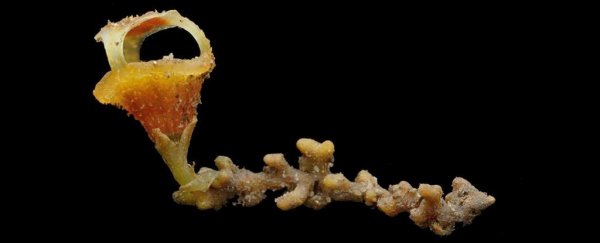Within the depths of a Malaysian rainforest's shadows an astonishing plant, lacking sunlight-eating leaves, bizarrely blooms. This small, otherworldly growth, belonging to a group of rare flowering plants known as fairy lanterns (Thismia), has just been scientifically described for the first time.
They're tiny plants, too deep within the forest to receive sunlight, and often emerge beneath the leaf litter, so they don't bother with photosynthesizing and have lost the ability to do so. They have no chlorophyll; instead, they siphon food through their roots from the fungal network shared by other rainforest plants.
These incredible mycorrhizal fungal networks connect large plant communities together via their roots, allowing plants to communicate with each other using electric signals and even send resources to each other. In turn, the fungi receive sustenance from the plants.
 (Siti-Munirah, et al Phytokeys, 2021)
(Siti-Munirah, et al Phytokeys, 2021)
Plants that do this, like fairy lanterns, are thought to have evolved from one of the plant parts of the mycorrhizal fungal partnership. They've cheated the system, however, and turned fully parasitic on the fungi network. This form of food acquisition is called myco-heterotrophy.
"The new species, which we name Thismia sitimeriamiae, is distinct from all other Thismia species known to science," taxonomist Mat Yunoh Siti-Munirah, from the Forest Research Institute Malaysia and colleagues wrote in their paper.
I'm so very proud that we named our new species after the mother of a rainforest explorer, who has dedicated his life to finding plants, and to conservation. https://t.co/I7t8s5sd0D
— Chris Thorogood (@thorogoodchris1) June 30, 2021
At only 2.2 centimeters (0.86 inches) tall, the greenish-brown plant was found in a primary rainforest of the Malaysian State of Terengganu, by photographer Nikong Dome in 2019, who lives alongside Indigenous communities in the area.
A delightful orangey-yellow, like a warm glowing light, T sitimeriamiae's flower is uniquely shaped – a delicate cone with an umbrella-like structure on top, as if it's providing some sort of shelter.
 (Siti-Munirah, et al Phytokeys, 2021)
(Siti-Munirah, et al Phytokeys, 2021)
While some species of fairy lanterns have been caught cavorting with fungus gnats, what pollinates T. sitimeriamiae is a curious mystery.
"The extraordinary architecture of the flower raises interesting questions about how it is pollinated," said botanist Chris Thorogood from Oxford University.
The type illustration I produced of the new species of fairy lantern (Thismia sitimeriamiae) we've just described. Shout out for my collaborator Siti-Munirah, and to Dome Nikong for discovering this special plant deep in the Malaysian rainforest 🙏🏻 pic.twitter.com/DsyayCSo3l
— Chris Thorogood (@thorogoodchris1) June 30, 2021
Siti-Munirah and colleagues have recommended the strangely flowering plant be classified as Critically Endangered due to its extreme rarity. Its home state has been deforested at an alarmingly rapid rate for logging and palm oil.
"Given the rarity and inaccessibility of the vast majority of species of Thismia (many of which have been found only once), [conservation in their original environment] seems to be the only realistic approach," the team wrote.
Only four individuals of T. sitimeriamiae have ever been seen. Wild boar activity has disturbed one of two of its only known locations. Sadly, it may already be extinct, as all attempts to relocate it so far have failed. But researchers are unlikely to give up on this unique flavor of life, just yet.
The plant has been described in PhytoKeys.
